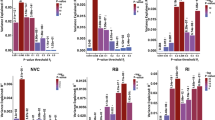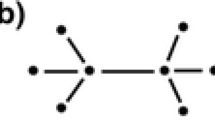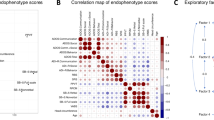Abstract
The functional link between genetic alteration and behavioral end-state is rarely straightforward and never linear. Cases where neurodevlopmental conditions defined by a distinct genetic etiology share behavioral phenotypes are exemplary, as is the case for autism and Fragile X Syndrome (FXS). In this paper and its companion paper, we propose a method for assessing the functional link between genotype and neural alteration across these target conditions by comparing their perceptual signatures. In the present paper, we discuss how such signatures can be used to (1) define and differentiate various aspects of neural functioning in autism and FXS, and subsequently, (2) to infer candidate causal (genetic) mechanisms based on such signatures (see companion paper, this issue).

Similar content being viewed by others
References
Abrahams, B. S., & Geschwind, D. H. (2008). Advances in autism genetics: On the threshold of a new neurobiology. Nature Reviews. Genetics, 9(5), 341–355.
Armstrong, V., Maurer, D., et al. (2009). Sensitivity to first- and second-order motion and form in children and adults. Vision Research, 49(23), 2774–2781.
Ashida, H., Lingnau, A., et al. (2007). FMRI adaptation reveals separate mechanisms for first-order and second-order motion. Journal of Neurophysiology, 97(2), 1319–1325.
Atkinson, J., Braddick, O., et al. (2006). Dorsal-stream motion processing deficits persist into adulthood in Williams syndrome. Neuropsychologia, 44(5), 828–833.
Atkinson, J., King, J., et al. (1997). A specific deficit of dorsal stream function in Williams’ syndrome. Neuroreport, 8(8), 1919–1922.
Baker, C. L., Jr. (1999). Central neural mechanisms for detecting second-order motion. Current Opinion in Neurobiology, 9(4), 461–466.
Baldassi, S., Pei, F., et al. (2009). Search superiority in autism within, but not outside the crowding regime. Vision Research, 49(16), 2151–2156.
Baron-Cohen, S., Ashwin, E., et al. (2009). Talent in autism: Hyper-systemizing, hyper-attention to detail and sensory hypersensitivity. Philosophical Transactions of the Royal Society of London. Series B, Biological Sciences, 364(1522), 1377–1383.
Behrmann, M., Thomas, C., et al. (2006). Seeing it differently: Visual processing in autism. Trends in Cognitive Sciences, 10(6), 258–264.
Belmonte, M. K., & Bourgeron, T. (2006). Fragile X syndrome and autism at the intersection of genetic and neural networks. Nature Neuroscience, 9(10), 1221–1225.
Belmonte, M. K., Cook, E. H., Jr., et al. (2004). Autism as a disorder of neural information processing: Directions for research and targets for therapy. Molecular Psychiatry, 9(7), 646–663.
Bertone, A., & Faubert, J. (2006). Demonstrations of decreased sensitivity to complex motion information not enough to propose an autism-specific neural etiology. Journal of Autism and Developmental Disorders, 36(1), 55–64.
Bertone, A., Hanck, J., et al. (2008). Development of static and dynamic perception for luminance-defined and texture-defined information. Neuroreport, 19(2), 225–228.
Bertone, A., Mottron, L., et al. (2003). Motion perception in autism: A “complex” issue. Journal of Cognitive Neuroscience, 15(2), 218–225.
Bertone, A., Mottron, L., et al. (2005). Enhanced and diminished visuo-spatial information processing in autism depends on stimulus complexity. Brain, 128(Pt 10), 2430–2441.
Blake, R., Turner, L. M., et al. (2003). Visual recognition of biological motion is impaired in children with autism. Psychological Science, 14(2), 151–157.
Bonnel, A., Mottron, L., et al. (2003). Enhanced pitch sensitivity in individuals with autism: A signal detection analysis. Journal of Cognitive Neuroscience, 15(2), 226–235.
Braddick, O., Atkinson, J., et al. (2003). Normal and anomalous development of visual motion processing: Motion coherence and ‘dorsal-stream vulnerability’. Neuropsychologia, 41(13), 1769–1784.
Brosseau-Lachaine, O., Gagnon, I., et al. (2008). Mild traumatic brain injury induces prolonged visual processing deficits in children. Brain Injury, 22(9), 657–668.
Casanova, M. F., Buxhoeveden, D. P., et al. (2002). Minicolumnar pathology in autism. Neurology, 58(3), 428–432.
Cavanagh, P., & Mather, G. (1989). Motion: The long and short of it. Spatial Vision, 4(2–3), 103–129.
Chen, Y., Levy, D. L., et al. (2003). Effects of typical, atypical, and no antipsychotic drugs on visual contrast detection in schizophrenia. American Journal of Psychiatry, 160(10), 1795–1801.
Chubb, C., & Sperling, G. (1988). Drift-balanced random stimuli: A general basis for studying non-Fourier motion perception. Journal of the Optical Society of America. A Optics and Image Science, 5(11), 1986–2007.
Churchill, J. D., Beckel-Mitchener, A., et al. (2002). Effects of Fragile X syndrome and an FMR1 knockout mouse model on forebrain neuronal cell biology. Microscopy Research and Technique, 57(3), 156–158.
Clifford, S., Dissanayake, C., et al. (2007). Autism spectrum phenotype in males and females with fragile X full mutation and premutation. Journal of Autism and Developmental Disorders, 37(4), 738–747.
Cohen, I. L. (1994). An artificial neural network analogue of learning in autism. Biological Psychiatry, 36(1), 5–20.
Comery, T. A., Harris, J. B., et al. (1997). Abnormal dendritic spines in fragile X knockout mice: Maturation and pruning deficits. Proceedings of the National Academy of Sciences of the United States of America, 94(10), 5401–5404.
Cornish, K. M., Munir, F., et al. (1999). Spatial cognition in males with Fragile-X syndrome: Evidence for a neuropsychological phenotype. Cortex, 35(2), 263–271.
Cornish, K. M., Turk, J., et al. (2004). Annotation: Deconstructing the attention deficit in fragile X syndrome: A developmental neuropsychological approach. Journal of Child Psychology and Psychiatry, 45(6), 1042–1053.
Cornish, K., Turk, J., et al. (2008). The fragile X continuum: New advances and perspectives. Journal of Intellectual Disability Research, 52(Pt 6), 469–482.
Dakin, S., & Frith, U. (2005). Vagaries of visual perception in autism. Neuron, 48(3), 497–507.
Del Viva, M. M., Igliozzi, R., et al. (2006). Spatial and motion integration in children with autism. Vision Research, 46(8–9), 1242–1252.
Derrington, A. M., & Lennie, P. (1984). Spatial and temporal contrast sensitivities of neurones in lateral geniculate nucleus of macaque. Journal of Physiology, 357, 219–240.
Dumoulin, S. O., Baker, C. L., Jr., et al. (2003). Cortical specialization for processing first- and second-order motion. Cerebral Cortex, 13(12), 1375–1385.
Eckert, M. A., Galaburda, A. M., et al. (2006). The neurobiology of Williams syndrome: Cascading influences of visual system impairment? Cellular and Molecular Life Sciences, 63(16), 1867–1875.
Farzin, F., Whitney, D., et al. (2008). Contrast detection in infants with fragile X syndrome. Vision Research, 48(13), 1471–1478.
Franklin, A., Sowden, P., et al. (2010). Reduced chromatic discrimination in children with autism spectrum disorders. Developmental Science, 13(1), 188–200.
Freitag, C. M., Konrad, C., et al. (2008). Perception of biological motion in autism spectrum disorders. Neuropsychologia, 46(5), 1480–1494.
Greenough, W. T., Klintsova, A. Y., et al. (2001). Synaptic regulation of protein synthesis and the fragile X protein. Proceedings of the National Academy of Sciences of the United States of America, 98(13), 7101–7106.
Gunn, A., Cory, E., et al. (2002). Dorsal and ventral stream sensitivity in normal development and hemiplegia. Neuroreport, 13(6), 843–847.
Gustafsson, L. (1997a). Excessive lateral feedback synaptic inhibition may cause autistic characteristics. Journal of Autism and Developmental Disorders, 27(2), 219–220.
Gustafsson, L. (1997b). Inadequate cortical feature maps: A neural circuit theory of autism. Biological Psychiatry, 42(12), 1138–1147.
Gustafsson, L. (2004). Comment on “disruption in the inhibitory architecture of the cell minicolumn: Implications for autism”. Neuroscientist, 10(3), 189–191.
Habak, C., & Faubert, J. (2000). Larger effect of aging on the perception of higher-order stimuli. Vision Research, 40(8), 943–950.
Hansen, P. C., Stein, J. F., et al. (2001). Are dyslexics’ visual deficits limited to measures of dorsal stream function? Neuroreport, 12(7), 1527–1530.
Happe, F., & Frith, U. (2006). The weak coherence account: Detail-focused cognitive style in autism spectrum disorders. Journal of Autism and Developmental Disorders, 36(1), 5–25.
Heaton, P., Hermelin, B., et al. (1999). Can children with autistic spectrum disorders perceive affect in music? An experimental investigation. Psychological Medicine, 29(6), 1405–1410.
Herbert, M. R. (2005). Autism: A brain disorder, or a disorder that affects the brain. Clinical Neuropsychiatry, 2, 354–379.
Irwin, S. A., Galvez, R., et al. (2000). Dendritic spine structural anomalies in fragile-X mental retardation syndrome. Cerebral Cortex, 10(10), 1038–1044.
Irwin, S. A., Idupulapati, M., et al. (2002). Dendritic spine and dendritic field characteristics of layer V pyramidal neurons in the visual cortex of fragile-X knockout mice. American Journal of Medical Genetics, 111(2), 140–146.
Irwin, S. A., Patel, B., et al. (2001). Abnormal dendritic spine characteristics in the temporal and visual cortices of patients with fragile-X syndrome: A quantitative examination. American Journal of Medical Genetics, 98(2), 161–167.
Kaiser, M. D., & Shiffrar, M. (2009). The visual perception of motion by observers with autism spectrum disorders: A review and synthesis. Psychonomic Bulletin & Review, 16(5), 761–777.
Karmiloff-Smith, A. (2007). Atypical epigenesis. Developmental Science, 10(1), 84–88.
Keita, L., Mottron, L., & Bertone, A. (in press). Far visual acuity is unremarkable in autism: Do we need to focus on crowding? Autism Research.
Keri, S., & Benedek, G. (2009). Visual pathway deficit in female fragile X premutation carriers: A potential endophenotype. Brain and Cognition, 69(2), 291–295.
Keri, S., Must, A., et al. (2006). Development of visual motion perception in children of patients with schizophrenia and bipolar disorder: A follow-up study. Schizophrenia Research, 82(1), 9–14.
Kim, J., Doop, M. L., et al. (2005). Impaired visual recognition of biological motion in schizophrenia. Schizophrenia Research, 77(2–3), 299–307.
Kogan, C. S., Bertone, A., et al. (2004a). Integrative cortical dysfunction and pervasive motion perception deficit in fragile X syndrome. Neurology, 63(9), 1634–1639.
Kogan, C. S., Boutet, I., et al. (2004b). Differential impact of the FMR1 gene on visual processing in fragile X syndrome. Brain, 127(Pt 3), 591–601.
Kohonen, K. (1995). Self-organizing maps. Springer: New-York.
Koldewyn, K., Whitney, D., et al. (2009). The psychophysics of visual motion and global form processing in autism. Brain.
Larsson, J., Landy, M. S., et al. (2006). Orientation-selective adaptation to first- and second-order patterns in human visual cortex. Journal of Neurophysiology, 95(2), 862–881.
Loesch, D. Z., Huggins, R., et al. (1993). Genotype-phenotype relationships in fragile X syndrome: A family study. American Journal of Human Genetics, 53(5), 1064–1073.
Losh, M., Sullivan, P. F., et al. (2008). Current developments in the genetics of autism: From phenome to genome. Journal of Neuropathology and Experimental Neurology, 67(9), 829–837.
McClelland, J. L. (2000). The basis of hyperspecificity in autism: A preliminary suggestion based on properties of neural nets. Journal of Autism and Developmental Disorders, 30(5), 497–502.
McKendrick, A. M., & Badcock, D. R. (2004). An analysis of the factors associated with visual field deficits measured with flickering stimuli in-between migraine. Cephalalgia, 24(5), 389–397.
Milne, E., Swettenham, J., et al. (2002). High motion coherence thresholds in children with autism. Journal of Child Psychology and Psychiatry, 43(2), 255–263.
Milner, A. D., & Goodale, M. A. (1995). The visual brain in action. New York: Oxford University Press.
Mottron, L., Dawson, M., et al. (2006). Enhanced perceptual functioning in autism: An update, and eight principles of autistic perception. Journal of Autism and Developmental Disorders, 36(1), 27–43.
Mottron, L., Dawson, M., et al. (2009). Enhanced perception in savant syndrome: Patterns, structure and creativity. Philosophical Transactions of the Royal Society of London. Series B, Biological Sciences, 364(1522), 1385–1391.
Mottron, L., Peretz, I., et al. (2000). Local and global processing of music in high-functioning persons with autism: Beyond central coherence? Journal of Child Psychology and Psychiatry, 41(8), 1057–1065.
Muhle, R., Trentacoste, S. V., et al. (2004). The genetics of autism. Pediatrics, 113(5), e472–e486.
Muller, R. A. (2007). The study of autism as a distributed disorder. Mental Retardation and Developmental Disabilities Research Reviews, 13(1), 85–95.
Nishida, S., Ledgeway, T., et al. (1997). Dual multiple-scale processing for motion in the human visual system. Vision Research, 37(19), 2685–2698.
Nishida, S., Sasaki, Y., et al. (2003). Neuroimaging of direction-selective mechanisms for second-order motion. Journal of Neurophysiology, 90(5), 3242–3254.
O’Brien, J., Spencer, J., et al. (2002). Form and motion coherence processing in dyspraxia: Evidence of a global spatial processing deficit. Neuroreport, 13(11), 1399–1402.
O’Riordan, M., & Passetti, F. (2006). Discrimination in autism within different sensory modalities. Journal of Autism and Developmental Disorders, 36(5), 665–675.
Pei, F., Baldassi, S., et al. (2009). Neural correlates of texture and contour integration in children with autism spectrum disorders. Vision Research, 49(16), 2140–2150.
Pellicano, E., & Gibson, L. Y. (2008). Investigating the functional integrity of the dorsal visual pathway in autism and dyslexia. Neuropsychologia, 46(10), 2593–2596.
Pellicano, E., Gibson, L., et al. (2005). Abnormal global processing along the dorsal visual pathway in autism: A possible mechanism for weak visuospatial coherence? Neuropsychologia, 43(7), 1044–1053.
Persico, A. M., & Bourgeron, T. (2006). Searching for ways out of the autism maze: Genetic, epigenetic and environmental clues. Trends in Neurosciences, 29(7), 349–358.
Reddy, K. S. (2005). Cytogenetic abnormalities and fragile-X syndrome in Autism Spectrum Disorder. BMC Medical Genetics, 6, 3.
Rogers, S. J., Wehner, D. E., et al. (2001). The behavioral phenotype in fragile X: Symptoms of autism in very young children with fragile X syndrome, idiopathic autism, and other developmental disorders. Journal of Developmental and Behavioral Pediatrics, 22(6), 409–417.
Simmers, A. J., Ledgeway, T., et al. (2003). Deficits to global motion processing in human amblyopia. Vision Research, 43(6), 729–738.
Simmons, D. R., Robertson, A. E., et al. (2009). Vision in autism spectrum disorders. Vision Research, 49(22), 2705–2739.
Skottun, B. C. (2000). The magnocellular deficit theory of dyslexia: The evidence from contrast sensitivity. Vision Research, 40(1), 111–127.
Smith, A. T., Greenlee, M. W., et al. (1998). The processing of first- and second-order motion in human visual cortex assessed by functional magnetic resonance imaging (fMRI). Journal of Neuroscience, 18(10), 3816–3830.
Spencer, J. V., & O’Brien, J. M. (2006). Visual form-processing deficits in autism. Perception, 35(8), 1047–1055.
Spencer, J., O’Brien, J., et al. (2000). Motion processing in autism: Evidence for a dorsal stream deficiency. Neuroreport, 11(12), 2765–2767.
Sperling, G., Chubb, C., et al. (1994). Full-wave and half-wave processes in second-order motion and texture. Ciba Foundation Symposium, 184, 287–303. discussion 303-8, 330-8.
Steyaert, J. G., & De la Marche, W. (2008). What’s new in autism? European Journal of Pediatrics, 167(10), 1091–1101.
Sutter, A., Sperling, G., et al. (1995). Measuring the spatial frequency selectivity of second-order texture mechanisms. Vision Research, 35(7), 915–924.
Theobald, T. M., Hay, D. A., et al. (1987). Individual variation and specific cognitive deficits in the fra(X) syndrome. American Journal of Medical Genetics, 28(1), 1–11.
Tommerdahl, M., Tannan, V., et al. (2008). Absence of stimulus-driven synchronization effects on sensory perception in autism: Evidence for local underconnectivity? Behavioral and Brain Functions, 4, 19.
Tsermentseli, S., O’Brien, J. M., et al. (2008). Comparison of form and motion coherence processing in autistic spectrum disorders and dyslexia. Journal of Autism and Developmental Disorders, 38(7), 1201–1210.
Ungerleider, L. G., & Mishkin, M. (1982). Analysis of visual behavior. Cambridge, MA: MIT.
Vandenbroucke, M. W., Scholte, H. S., et al. (2008). A neural substrate for atypical low-level visual processing in autism spectrum disorder. Brain, 131(Pt 4), 1013–1024.
Vandenbroucke, M. W., Scholte, H. S., et al. (2009). A new approach to the study of detail perception in Autism Spectrum Disorder (ASD): Investigating visual feedforward, horizontal and feedback processing. Vision Research, 49(9), 1006–1016.
Vattikuti, S., & Chow, C. C. (2009). A computational model for cerebral cortical dysfunction in autism spectrum disorders. Biological Psychiatry.
Wassink, T. H., Piven, J., et al. (2001). Chromosomal abnormalities in a clinic sample of individuals with autistic disorder. Psychiatric Genetics, 11(2), 57–63.
Wilmer, J. B., Richardson, A. J., et al. (2004). Two visual motion processing deficits in developmental dyslexia associated with different reading skills deficits. Journal of Cognitive Neuroscience, 16(4), 528–540.
Wilson, H. R., Ferrera, V. P., et al. (1992). A psychophysically motivated model for two-dimensional motion perception. Visual Neuroscience, 9(1), 79–97.
Acknowledgments
Supported by funding from a Canadian Institutes of Health Research (CIHR)-Clinical Research Initiative fellowship to AB, a Fonds de la Recherche en Santé du Québec (FRSQ) doctoral scholarship to JH, a CIHR-Canada Research Chair (Tier 1) to KC, a Natural Sciences and Engineering Research Council of Canada discovery grant to CK, and a CIHR Operating Grant to KC and AC.
Author information
Authors and Affiliations
Corresponding author
Rights and permissions
About this article
Cite this article
Bertone, A., Hanck, J., Kogan, C. et al. Using Perceptual Signatures to Define and Dissociate Condition-Specific Neural Etiology: Autism and Fragile X Syndrome as Model Conditions. J Autism Dev Disord 40, 1531–1540 (2010). https://doi.org/10.1007/s10803-010-1109-5
Published:
Issue Date:
DOI: https://doi.org/10.1007/s10803-010-1109-5




